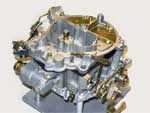
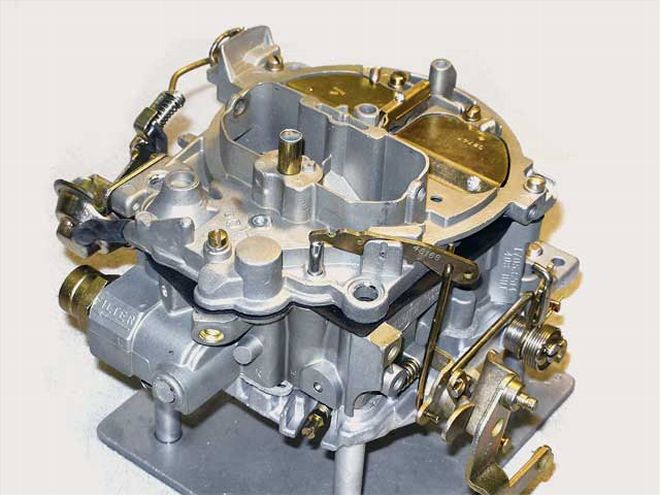 When modified and tuned correctly, a Rochester Quadrajet (such as this Stage 3 Jet Performance carburetor) can become an effective racing carburetor.
When modified and tuned correctly, a Rochester Quadrajet (such as this Stage 3 Jet Performance carburetor) can become an effective racing carburetor.
There is a reason Holley and Demon carburetors are widely considered among the best high-performance carburetors available. They are designed to make optimum power, easy to adjust, and relatively simple to work on. Given their success, it isn't hard to see why other carburetor designs have been overlooked when it comes to circle track racing.
But among all the others, there is one, known as the Rochester Quadrajet, that some racers should consider as a legitimate racing option. The Quadrajet was ubiquitous on practically every carbureted Chevy engine installed in a car in the '70s and early '80s. Because it is so common, many racetracks allow the carburetor in the stock racing classes. Often, racers are given the option of racing a two-barrel Holley or a Quadrajet. Many consider the four-barrel Q-jets barely the equivalent of the two-barrel carbs because they were designed to work on passenger cars and put a premium on sipping gas. However, given the right tuning upgrades, the extra two barrels give the Q-jet a leg up on the competition.
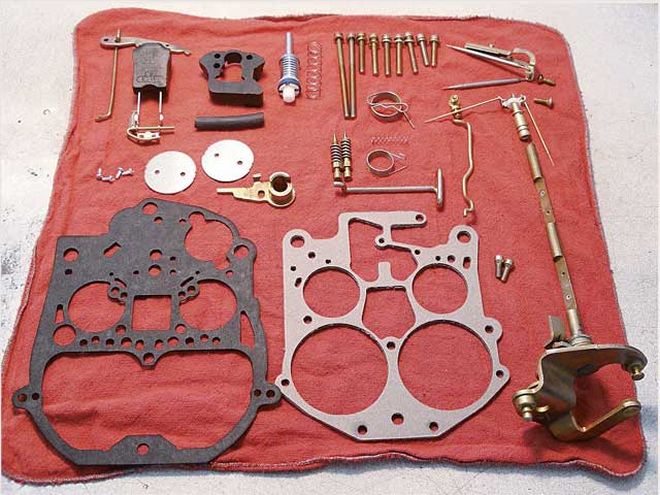 They may look different, but the primary components of the Q-jet function similarly to that of the Holley.
They may look different, but the primary components of the Q-jet function similarly to that of the Holley.
"The big difference between a four-barrel Holley, which everybody is familiar with, and a Quadrajet is the Holley has a square bore, meaning all the throttle bores and venturis are the same size, while the Quadrajet is a spread-bore carburetor," says Johnny Valdez of Jet Performance. "That means it has small primaries with larger secondary throttle bores. Another difference is four-barrel Holleys have two float bowls, two needles and seats, and most have dual fuel inlets. The Rochester has only one float bowl and one needle, as well as a single fuel inlet. So it's a four-barrel, but it has approximately half the fuel capacity since it has only one needle and seat. This can cause fuel starvation in a racing situation with an unmodified carburetor. The good news, though, is that with the right tuning modifications, a Rochester can be a very good carburetor with great throttle response on the racetrack."
Jet Performance Products specializes in turning ordinary Q-jet cores into race-ready carburetors. The modifications that Jet makes to a Quadrajet to create its full-on race unit (called the "Stage 3") are significant, but the end result is a carburetor that is more reliable, provides better throttle response, and works better on the racetrack.
Core Issues
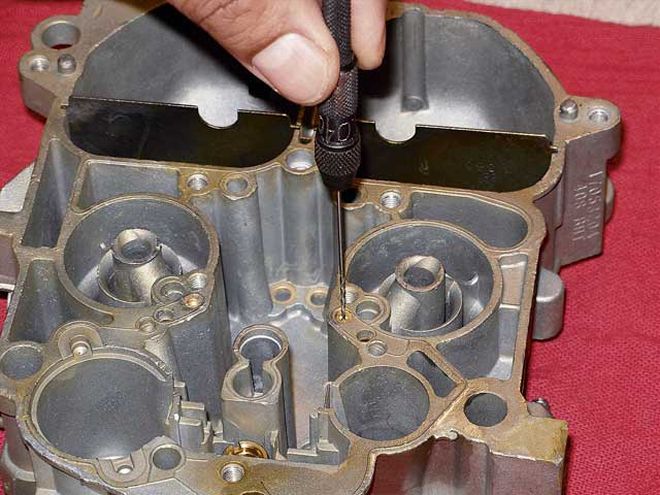 The idle circuit is modified because a race motor-even at idle-consumes more air and fuel than its stock cousin.
The idle circuit is modified because a race motor-even at idle-consumes more air and fuel than its stock cousin.
According to Valdez, the first step is finding the correct Quadrajet to serve as a core. Fortunately, the carburetors are still relatively easy to find; the trick is to find the type that you need. Older Q-jets are more likely to have damage or wear that will cause you trouble down the line, so you want to look for the newest unit you can find. "The ones we recommend you look for are on late-model Chevys," he says. "Anything that's '77 through '84 and non-computerized, obviously. Those are a little more tunable, and they have the APT adjustment. APT stands for `adjustable part throttle' and it allows you to tune the carburetor a little more precisely. The advantage is that it allows you to tune it better for idle and off-idle acceleration."
If you are sorting through a bunch of carburetors sitting on a shelf and not hunting through a bunch of cars in a junkyard, Valdez says you can check the part numbers. The first three digits on a late-model carb are "170," while earlier units will start with either "704" or "702."
Finally, Quadrajets also came in two different sizes. Passenger cars were equipped with a 750-cfm unit while trucks, vans, and Suburbans were normally equipped with a Quadrajet capable of flowing 800 cfm. From its experience, Jet Performance recommends the 750 carb to racers using a 350 with stock-style heads, but if you are racing an engine 400 ci or larger or with better heads, you may need to move up to the 800-cfm version.
The Upgrade List
Before beginning the upgrade and modification process on a Quadrajet, tear it down and thoroughly inspect every part for damage or excessive wear. Jet Performance's program includes several steps. After thoroughly cleaning the core, the baseplate is resurfaced to bring the flatness back to spec, and throttle shaft bushings are installed because that is an area that always shows significant wear.
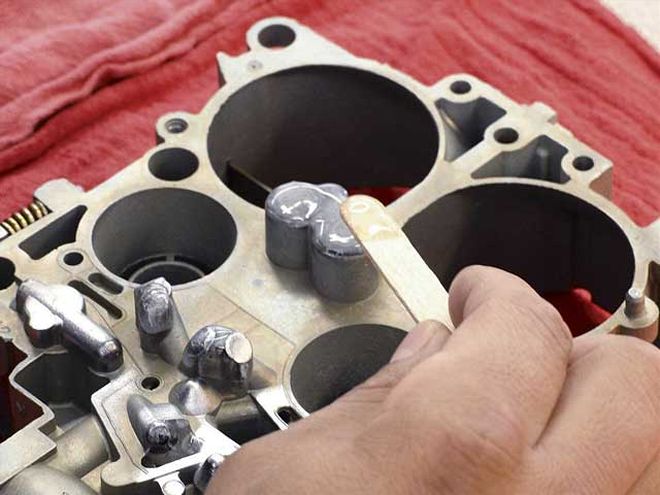 The well plugs are epoxied to ensure that no air leakage throws off the carb's ability to properly mix air and fuel.
The well plugs are epoxied to ensure that no air leakage throws off the carb's ability to properly mix air and fuel.
The next step is to seal the well plugs in the main body. The plugs are a source of air leakage, so the new plugs are epoxied in place to ensure a good, long-lasting seal. The accelerator pump orifice is also plugged.
"We also change the accelerator pump and install a larger needle and seat," Valdez adds. "One of the most important things we modify is the idle circuit. A circle track race motor has a bigger camshaft with longer duration and higher lift than a stock cam, so they have different needs. You have to set up the baseplate so that it allows more air for idling so you don't expose the throttle plates out of the transfer slot and get nozzle drip.
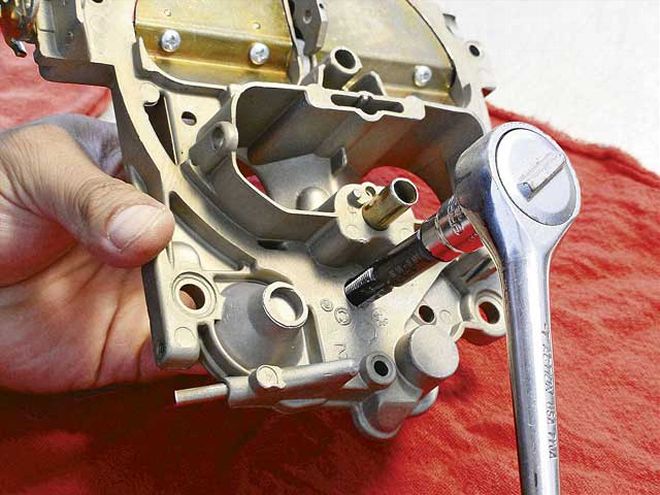 The air horn for the adjustable part throttle control is tapped and given its own access plug.
The air horn for the adjustable part throttle control is tapped and given its own access plug.
"We also modify the choke pull that allows the air door for the secondaries to open up a little bit faster, but not too fast. The secondaries are manual, but they have an upper air door that works off of vacuum. You want that to open up quickly so that it gives you good acceleration out of the turns."
The result, Valdez says, is a carburetor that's crisper in response than it ever was in stock form. Proper tuning is not only critical for throttle response, however. When done correctly, it also makes the carburetor much more efficient and practically eliminates the tendency for the single float bowl to be sucked dry by the end of the straight. So if your rule book allows you to run a Rochester Quadrajet, don't dismiss the option out of hand. It might just be able to give you the advantage you've been looking for.